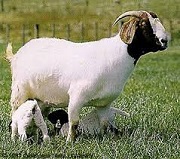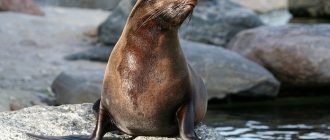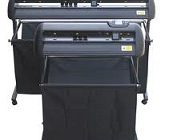Interested in South African boer goats? Learn more about the boer goats in South Africa…
The South African boer goat was specially developed in the early 20th century for meat production. The name comes from the Dutch word for farmer, which is “boer”. The goat was bred as a mixture of the indigenous goat of the Namaqua Bushmen and Fooku tribes. However, there was some crossbreeding with the European and Indian goat blood lines involved as well. The main aim was to produce meat rather than milk and continued selective breeding lead to an increased supply and yield of meat. Due to this constant improvement it provides excellent carcass quality and has a very high growth rate. That has made them very popular around the world as meat goats.
The South African boer goats are very hardy and disease resistant. They thrive well in bright and hot semi-desert conditions. Initially the stocks around the world were supplied through New Zealand and other parts of the world where the Dutch colonists had settled. However much later they were directly imported from South Africa into different parts of the world.
Characteristics of the Goats
The South African Boer goats have bulky bodies that are white in color and very distinctive heads, which are brown. Similar to the Nubian goat the ears are long and pendulous. They are exceptionally hostile and grow at a very rapid rate. The fertility rate is also quite exceptionally high and the does are reported to have exceptional mothering skills when compared to other breeds. That means that the infant mortality rate is very low and the breed grows well. As far as the weight of the mature boer buck is concerned, it ranges in between 240 – 300 lb while the mature does weighs around 200 – 220 lb.
Use as Commercial Meat Production
In terms of meat production these animals graze independently and prefer shrubs, broadleaf weeds and brush instead of grass. The meat producing boer goats are generally raised on free pastures as they end up being healthier than confined animals. Furthermore, the costs go down substantially when they feed on weeds and brush rather than on several bags of commercial goat feed. Ideally they should graze all year round in open fields and be supplemented with minerals. They can also be raised in combination with other livestock like sheep and cattle as they do not destroy or consume the grass cover that is eaten by the other livestock.
For good health certain trace minerals like copper are very beneficial. Any of the mineral blocks that are marked for goats and sheep should be avoided completely. Copper actually is beneficial for the goat and toxic for the sheep therefore the mixed feed will have inadequate amounts of copper for the goat.
Top Quality Sires
A male boer goat should be a good selection as the herd sire or the breeding buck. The main reason for that is that the resultant offspring of a high quality buck is of high quality even though it has been mated with an average doe. The South African boer starts gaining weight at roughly the same rate as the sire, so it is essential to choose the buck from a known fast growing bloodline. It will not only command the highest price but an overall benefit can be attained when it is crossbred and used for meat production.
In the market the slaughter goats range between 35-80 lb for the kid. It should ideally be exercised at the age of weaning. Sometimes the known sources of good quality sires produce kids that weigh up to 80 lb – 90 lb. In comparison the poor quality sire can result in a kid, which ends up being only 35 lb at the 90-day mark. Even though the average quality buck may be comparatively inexpensive when you purchase it, the real loss will be noticeable when the kids are produced. The long-term profitability is definitely undermined as they produce lighter weight and lower quality kids.





